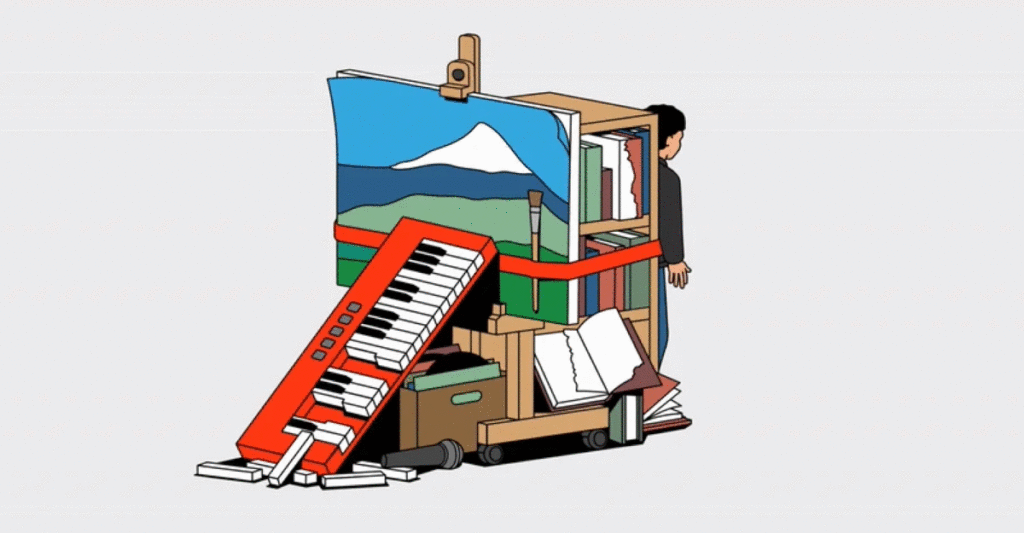Twenty-five years into the 21st century, culture is markedly different than it was in the previous millennium. Everyday life has never contained more stuff—an endless reel of words, ideas, games, songs, videos, memes, outrageous statements, celebrity meltdowns, life hacks, extremely talented animals. Yet audiences can sense what’s missing. For all the energy society invests in culture today, little has emerged that feels new, and certainly nothing revolutionary enough to properly outmode the past.
Some commentators have argued that cultural progress is at a standstill. In The Crisis of Culture, published in English in 2024, the French political scientist Olivier Roy claims that the canon has been abandoned, subcultures have been reduced to superficial identity groups, and the marketplace has swallowed everything. As a full diagnosis, this seems too pessimistic. In its broadest definition, culture always exists, and subcultures remain—there are just fewer conspicuous ones now, and those have less influence. The canon is not dead; the problem, rather, is that it casts too long a shadow over the present. Kurt Cobain would have wanted the next generation’s musicians and listeners to kill their idols, including him. Instead, they wear his face on T-shirts.
Still, the lingering reverence toward Cobain and other larger-than-life 20th-century artists suggests a deeply rooted collective respect for the agents of radical cultural change. What’s missing now is a veneration of the artistic mindset, which possesses the imagination to reject kitsch—art that trades in well-worn formulas, stock emotions, and immediate comprehensibility—and pursue work that expands the possibilities of human perception. Doing so requires at least some creators in the cultural ecosystem to strive for complexity, ambiguity, and formal experimentation—attributes that power the masterpieces that draw millions of people every year to museums.
The first step in reversing cultural stagnation is to accept that artistic invention is a social good. And like so many other social goods, it isn’t necessarily going to have its production prioritized by the market. We—creators and audiences alike—have to make an effort to encourage bold new forms of culture. Even failures and half steps will be more interesting than overly market-tested products.
Restoring cultural invention doesn’t require upending the current industries—it just needs a small vanguard to change its direction. Throughout history, dedicated enclaves, such as the avant-garde artists of the early 20th century and urban subcultures of the late 20th century, have pursued innovation without the promise of immediate financial reward. Creating more of these communities and supporting them is crucial.
Perhaps the key way of doing this is to restore collectively meaningful, noneconomic incentives for the creation of art. For more than a century, the world’s most creative people have been suspicious of “social norms.” Norms were, after all, the foundation of middle-class respectability—the very thing that stifled genius—and by the mid-20th century, to be “cool” meant rejecting staid convention. Eventually, a great number of multinational corporations agreed: Customs, manners, and taboos were merely obstacles to market expansion.
The result was a world in which only money provided a universal sense of value. In turn, the erosion of norms left us defenseless against disinhibited opportunists who learned to hack the system. The media have dutifully amplified every outrage, and norm breakers, such as Kanye West (who now goes by “Ye”) and Donald Trump, rose as our cultural leaders through sheer volume of content alone.
But social norms remain a powerful tool for ensuring that self-interest doesn’t erode the collective good. Consider the late-20th-century taboo against “selling out,” a norm that steered young artists away from chasing wealth as they pursued their art. Because experimentation rarely paid in the short term, social rewards—status, respect, admiration—became vital for sustaining artists on a path of invention.
Critics play a significant role in this process. Although critics have been writing about popular culture for decades, they had traditionally used their platforms to elevate daring, innovative work. These positive reviews conferred status on artists, helping audiences feel a sense of pride in their affinity for “cult” works. The director David Lynch died a legend because of critical support and cultish fandom, not the rewards of the marketplace.
This is not the direction that criticism veered in the 21st century, however. An emerging set of critics worried that complex, experimental culture was inherently elitist, deployed by the educated to make everyone else feel inferior. In this view, dismissing pop culture wasn’t just snobbery; it denied people their right to take pleasure from their favorite bangers and bops. But in focusing too much on what was popular, critics began to write about culture like sports, concentrating most on the major leagues.
Culture isn’t sports, though. The minor leagues of niche subcultures and marginalized communities have always been the most important crucibles of innovation. Passive consumers indifferent (or even hostile) to high art may not actively seek out challenging work, but they instinctively grow bored with repetition. Hip-hop’s longevity comes from its ability to follow the lead of its young Turks, resulting in a decades-long chain of stylistic evolution. When critics deny this central dynamic by overfocusing on the big players, they help create a landscape that feels stagnant, even if interesting stuff is happening out there somewhere.
[Read: The diminishing returns of having good taste]
A much more expansive critical approach means thinking about culture as a sort of terroir. When forward-thinking artists are celebrated, their original ideas eventually permeate other layers of the cultural ecosystem, ensuring that even mainstream culture becomes vibrant and exciting rather than interminably recycling its own past. Everybody wins. Critics and tastemakers play an essential role in this work, but they must, as the late cultural theorist Mark Fisher wrote, abandon cynicism and believe again that audiences are capable of engaging “with cultural products that are complex and intellectually demanding.”
Artists themselves also have to rethink their work outside the individual pursuit of fame and profit. Every enduring cultural movement—hip-hop, rock, punk, streetwear—began as an insular, tightly knit community of like-minded peers that formed out of a dissatisfaction with the conventional and a deep desire to create something new. Historically, these subcultures existed in real-world spaces—clubs, skate parks, dive bars, DIY venues—where ideas evolved organically.
Today, such subcultures have largely migrated online. Although digital spaces allow people to find their niches more easily, the omnipresence of pop culture means that some of the most energetic subcultures are now fan communities devoted to existing mass-market entertainment—or nihilistic trolls whose innovations are unlikely to ever inspire worthwhile artists. Yet subcultures operating in the old model—such as drag queens, Chicago drill, and Atlanta trap—have profoundly reshaped culture at large. Mainstream consumers still crave the energy of subcultural innovation and enjoy seeing underground ideas fused with commercial styles. But the existing places to pull from are nearly exhausted, and reviving culture requires a new generation of outsiders willing to create their own movements from scratch.
Unfortunately, the current media ecosystem discourages this. The major internet platforms encourage creators to chase virality rather than cultivate smaller, self-sustaining communities. Global brands tease lucrative deals to emerging artists and micro-influencers, reinforcing the idea that “getting the bag” is the ultimate goal. As the art critic Jerry Saltz has observed, “It’s almost impossible for fragile underground scenes to grow, get nurtured, and take root, especially when we move at light speed.” Ice Spice, who came up in the drill scene, faced little pushback for taking money from Dunkin’. In an era when we live as personal brands, every decision is made to increase our own shareholder value.
Making art with lasting meaning requires resisting the pull of instant exposure and early buyouts. We must think through ways to encourage artists to disappear into their own worlds for a while, developing ideas away from corporate influence and assimilation. Not everyone will have the discipline or capacity for this, but those who do or can will shape the future. And the least that critics and fans can do is give them esteem—when justified—for attempting to move culture forward, instead of ignoring them as marginal, castigating them as pretentious, or belittling their view counts. The past 25 years have taught us that the contemporary economy and media will not prioritize creative invention. The question is: Will you?
This article has been adapted from W. David Marx’s new book, Blank Space: A Cultural History of the Twenty-First Century.
The post 21st-Century Culture Has Hit a Wall. Here’s How to Break Through. appeared first on The Atlantic.




